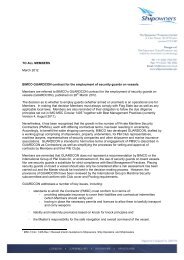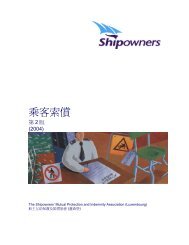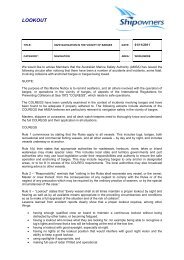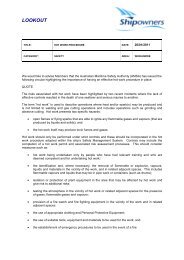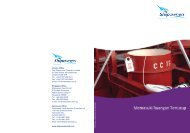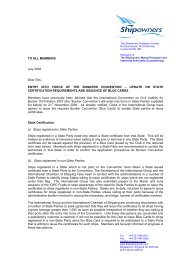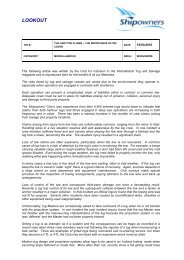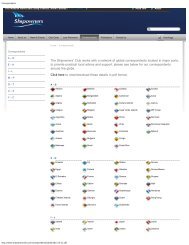Maintenance of Switchboard Safety Systems - Shipowners
Maintenance of Switchboard Safety Systems - Shipowners
Maintenance of Switchboard Safety Systems - Shipowners
You also want an ePaper? Increase the reach of your titles
YUMPU automatically turns print PDFs into web optimized ePapers that Google loves.
If the details on the last overhaul and last test (based on either set ‘operating hours’ or ‘calendar-timepassed’) are not available on an item or system this should also be highlighted as a potential hazard.Where this is the case the manufacturer’s testing and maintenance requirements should be applied atthe earliest possible opportunity. The sound and detailed reporting <strong>of</strong> maintenance must always beundertaken as it is important information for the future.<strong>Switchboard</strong> <strong>Safety</strong> Surveys, Tests and ReportingThere are many types <strong>of</strong> tests that need to be undertaken to ensure that main electrical switchboardsare safe and operating correctly. Planning maintenance around these required tests and safetychecks is important.So too is recording what tests have been undertaken, a detailed description <strong>of</strong> what was done andwhat the results were. It is important to get electrical surveyor support in arranging the content <strong>of</strong> themaintenance plan for each <strong>of</strong> the main items in a switchboard.Of key importance is the regular survey, testing and recorded testing <strong>of</strong> the following items:• the earthing <strong>of</strong> all structural elements <strong>of</strong> the switchboards (including any doors with lights orcontrols) and provision <strong>of</strong> insulating mats on the floor around the switchboard;• the cleanliness and close visual inspection <strong>of</strong> the elements within the switchboard;• the protection <strong>of</strong> the switchboard from piping systems, condensation or water-ingress;• the functionality <strong>of</strong> all controls, lights and meters (and their appropriate marking and labelling);• the functionality <strong>of</strong> any power management systems (if arranged);• the functionality <strong>of</strong> all automatic control system (any auto-starts or stand-by functions);• the functionality, set-point and delays <strong>of</strong> ‘under-voltage’ circuit breaker trips on the shut-down(or de-clutch) <strong>of</strong> the power generator prime-movers (the ship’s generators or main shaftalternators);• the functionality, set-point and delays <strong>of</strong> ‘reverse-power’ circuit breaker trips for generatoralternators• the functionality, set-point and delays <strong>of</strong> ‘over-current’ circuit breaker trips for generatoralternators, through the simulated ‘secondary injection testing’ on board (or full ‘primaryinjection testing’ ashore);• the functionality and verification <strong>of</strong> the set points <strong>of</strong> the engine room alarm system testedunder both normal and emergency power;• the testing <strong>of</strong> back-up power arrangements (normally batteries), their charging and ability totake over the powering <strong>of</strong> the alarm system without causing failures or false alarms.The interval <strong>of</strong> the above surveys and tests should be discussed with your Surveyor or ClassificationSociety.The time intervals for each survey or test and the supported methods for reporting (and recordkeeping) <strong>of</strong> each one should also be detailed within your planned maintenance system ormaintenance plan.UNQUOTESource <strong>of</strong> information: http://www.maritimenz.govt.nz/Publications-and-forms/Commercialoperations/Shipping-safety/<strong>Safety</strong>-updates/Issue23-mnz-safety-bulletin-august-2010.pdf



